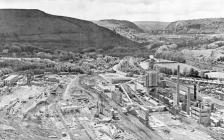Nantgarw Colliery - once the deepest coal mine in south Wales
Items in this story:
Parc Nantgarw
Anyone visiting Amgueddfa Cymru's Collections Centre at Parc Nantgarw, north of Cardiff, might not realise that this was once the site of one of the most famous collieries in south Wales. All that now remains are two small concrete pyramids marking the sites of the shafts and a commemorative winding wheel.
The deepest mine in south Wales
Nantgarw Colliery was one of the flagships of the National Coal Board. It was the nearest deep mine to Cardiff, and a reminder to travellers that they had entered the south Wales coalfield.
Opened in 1911, it boasted two large shafts and, at a depth of 782.73m (856 yards), was the deepest mine in south Wales. However, despite appearing as a fine example of a clean and efficient modern coal industry, the colliery was abandoned in 1927 due to lack of manpower, poor industrial relations and, above all, being located above very complex underground geology.
The war years
The mine re-opened in 1937 after a major reorganization, but work was suspended when war broke out in 1939. A later project to re-open the colliery was approved by the Ministry of Fuel and Power in 1946. It was the first major scheme to be operated by the new NCB in the south-west district.
A new state-of-the-art colliery
In order to construct a model colliery at Nantgarw, all traces of the original were demolished and new surface buildings were designed with state-of-the-art facilities. Appliances were installed to reduce smoke and fumes, and all waste was placed underground keeping the surface clear of unsightly spoil heaps. The entire underground network was designed to minimise the risk of accidents. Great care was taken to minimise any dust produced both underground and on the surface, in order to protect the workforce from contracting illnesses such as pneumoconiosis.
Not enough miners to mine
During the 1940s there was a marked decline in the number of men willing to consider a coal mining career, even in the traditional mining strongholds such as the Rhondda.
The Nantgarw Colliery posed a specific manpower problem, with the working population choosing employment elsewhere. The workforce had to be recruited from new entrants or from closed collieries outside the area. By 12 March 1954 the total cost of the project had increased to £5.25 million. Labour relations were also a cause for concern. During 1958 alone there were 65 stoppages, go-slows and walk-outs in the colliery
Declining fortunes
Nantgarw survived the mass pit closures of the 1960s and, in 1975, merged with Windsor Colliery (near Abertridwr). By 1979, the combined Nantgarw / Windsor Colliery employed around 650 men, producing over 4,000 tons of coal per week. During 1979–80 they made a profit of just over £0.5 million. Despite development difficulties, the pit's future looked reasonably secure.
However, by the early 1980s the colliery's fortunes were again hit by low manpower and poor geological conditions. The colliery lost £7 million in 1981, and in 1982 output declined steeply as a major coal seam became unworkable. A year later, an overtime ban led directly to the twelve-month strike of 1984-5. Within eighteen months of the strike ending, the mass pit closures took place in south Wales. This time, Nantgarw Colliery was included. Nearly 80 years of coal mining history at Nantgarw ended.

